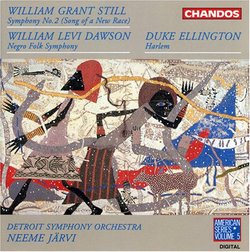This is incredible
Paul Beaudry | Forest Hills, NY United States USA | 12/03/2007
(5 out of 5 stars)
"This CD is amazing. I wish all of Still's symphonies were recorded by Chandos with Järvi conducting the Detroit Symphony as this and the Still #1 are of the highest quality in it's composition, recording, and performance. These pieces are indispensable for those wanting an essential view of American music and particularly African-American classical music. As much as Still #1 has gotten much attention world-wide I like this one better and it's never talked about. What an oversight. The Dawson piece is also amazing and this is the first time I've heard of him. You can be sure I never forgot him after hearing this! Also Ellington, is of course, Ellington - one of the greats of all time. How I wish Still #3, 4, and 5 would have been recorded in the same series with some of these other surprise gems. Chandos has such a high recording quality and Järvi with Detroit just nail this music. I've heard there is a recording of Still #3 out there but not with a major orchestra. If you're even thinking about buying this, grab it before it goes out of print. This is high quality stuff and this CD is one of my favorites in my 2000+ CD collection. That's a high standard to stand out among that many recordings."
Colorful American Music from an Orchestra that "Gets It"!
Moldyoldie | Motown, USA | 05/05/2009
(5 out of 5 stars)
"A few months ago I was introduced to the music of William Grant Still (d. 1978) via these same forces in their recording of his Afro-American Symphony (Still: Symphony No. 1; Ellington: Suite from "The River"), purported to be the first such work by an African-American composer to be played by a major orchestra (the New York Philharmonic in 1930). I commented: "....while this symphony is fleetingly entertaining, it's not a very elaborate musical expression." Still's second symphony "Song of a New Race" seemingly eschews much of the European-derived formalism heard in that earlier work and strives for a more "homegrown" classical/folk idiom. Again, Järvi and the DSO immerse themselves in it, though here their playing is freer and more alive to the expressive possibilities the score presents. Irrespective of the composer's own predilection to "....[represent] the American colored man of today; in so many instances a totally new individual produced through the fusion of white, Indian, and Negro bloods....", this later music (premiered in 1937 by Leopold Stokowski and the Philadelphia Orchestra) presents the listener with a more delightfully varied, colorful, and thoroughly American expression while adhering to classical musical ideals. Though culminating powerfully, the symphony oddly ends on a harumph of a note, but...
...it segues most comfortably with the Negro Folk Symphony of William Levi Dawson (d. 1990), a renowned arranger of choral spirituals and whose long career included founding the music school at Tuskegee Institute. According to the notes, he began work on his symphony in Chicago where he received his master's degree in composition from the American Conservatory of Music and later presented the score to Stokowski in New York while touring with the Tuskegee Choir. Suggestions were made by the famous maestro for the work's expansion and the final work was premiered by the Philadelphia Orchestra in 1934. The first movement, titled "The Bond of Africa", commences with a soulful clarion theme on a solo French horn which is echoed and varied throughout by strings, winds and dynamically by the trombones -- it peculiarly evokes in this listener's mind a sort of African-American Wagner! The second movement, "Hope in the Night", begins softly but leads to some powerful swells of various percussion and brass again echoing the main theme. The finale, "O, le' me shine, shine like a Morning Star!", is a colorful and uplifting working of the main theme with the DSO treating us to a wide-ranging and exhilirating orchestral workout.
Duke Ellington (d. 1974) was world famous when he composed Harlem in 1950 on the sea voyage home from a successful European tour with his band. Again according to the notes, it was originally commissioned by Arturo Toscanini to be part of a Portrait of New York suite, but the maestro's infirmities precluded him from conducting the piece. Ellington's band recorded it in 1954 and Don Gillis performed it in Carnegie Hall the following year with the Symphony of the Air, the successor to Toscanini's NBC Symphony Orchestra. If you've yet to hear it, this is about as colorful, jazzy, and swingin' as an orchestra gets! The DSO revels in it...and I can just picture Estonian giant Neeme Järvi groovin' uncontrollably and tapping his toes on the podium!
As per usual in Detroit's Orchestra Hall, Chandos provides the most naturally vivid recorded sound imaginable for a most entertaining 74 minute program."


 Track Listings (8) - Disc #1
Track Listings (8) - Disc #1